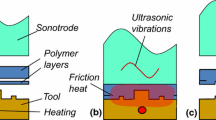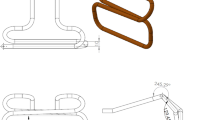Abstract
We succeeded to transfer a precise micro-pattern combining with an ultrasonic vibration in an atmospheric hot embossing on the almost same condition as a vacuum hot embossing. This paper reports the effect of the ultrasonic vibration that was verified experimentally. In the conventional method, a metallic mold and a plastic sheet are heated more than the glass transition temperature of the plastic, and the softened plastic is flowed into the pattern only by applying a load. On the other hand, a longitudinal ultrasonic vibration is added in the molding process of an ultrasonic-vibration hot embossing. The synergy effect of the load and the ultrasonic vibration enables flowing of the plastic into a more precise pattern of the metallic mold. The longitudinal wave generated by an ultrasonic vibration system of the frequency 15 kHz and output 900 W. A pattern of the Ni mold used in the experiment was a pyramid hole in which a peak was cut and sidewalls were rounded. Entrance lengths of pyramids were from 100 to 530 μm and its all of the depth were 260 μm. A polycarbonate was chosen with a replication material. Compared with the condition that the ultrasonic vibration was not used, a contact force and a contact time could be reduced to about 1/3 and 1/12, respectively.








Similar content being viewed by others
References
Becker EW, Ehrfeld W, Hagmann P, Maner A, Münchmeyer D (1986) Fabrication of microstructures with high aspect ratios and great structural heights by synchrotron radiation lithography, galvanoforming, and plastic moulding (LIGA process). Microelectron Eng 4:35–42
Chou SY, Krauss PR, Renstrom PJ (1995) Imprint of sub−25 nm vias and trenches in polymers. Appl Phys Lett 67:3114
Heckele M, Bacher W, Müller KD (1998) Hot embossing—the molding technique for plastic microstructures. Microsystem Technol 4:122–124
Heckele M, Dittrich H, Guber A, Schaller T (2001) Double-side hot embossing of microstructures. HARMST’01, Book of abstract pp 137–138
Mekaru H, Yamada T, Yan S, Hattori T (2004) Microfabrication by hot embossing and injection molding at LASTI. Microsystem Technol 10:682–688
Roos N, Wissen M, Scheer H, Glinsner T (2003) Impact of vacuum environment on the hot embossing process. SPIE’s microlithography pp 22–28
Yamada T, Mekaru H, Ishigaki H, Hattori T, Kitazima A, Maeda R (2002) Microfabrication of polymer microstructure using hot embossing. In: Proceedings of JSME/ASME international conference on materials and processing 2002 2:597–600
Acknowledgements
We would like to thank Mr. Hidetsugu Tanaka of Ultrasonic Engineering Co., Ltd. for having lent the ultrasonic vibration generator. We would like to thank Mr. Takashi Yamada who completed the graduate school of engineering, Himeji Institute of Technology in 2003 for his contributions in the experiment. This research was executed with the vacuum hot embossing device that developed in a contract research of the New Industry Research Organization (NIRO) supported financially by the Ministry of Economy, Trade and Industry of Japanese government.
Author information
Authors and Affiliations
Corresponding author
Rights and permissions
About this article
Cite this article
Mekaru, H., Nakamura, O., Maruyama, O. et al. Development of precision transfer technology of atmospheric hot embossing by ultrasonic vibration. Microsyst Technol 13, 385–391 (2007). https://doi.org/10.1007/s00542-006-0203-2
Received:
Accepted:
Published:
Issue Date:
DOI: https://doi.org/10.1007/s00542-006-0203-2




